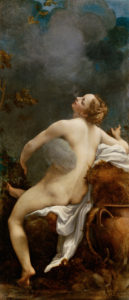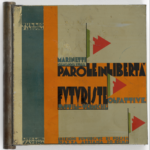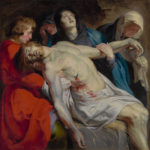Sfumato
Antonio Allegri da Correggio (1489-1534), Jupiter and Io, oil on canvas, 164 x 70 cm, c. 1532, Vienna, Kunsthistorisches Museum.
In early sixteenth-century Italy the painterly technique known as Sfumato, initially elaborated by Leonardo da Vinci, became synonymous with modern art. Following Leonardo’s example artists began blurring the outlines of their figures while defining their volume through plays of light and shade.
This method, often characterised as optical naturalism, represents more than visual perception. At a literal level sfumato consists in replacing the lines delimiting the human body, the main subject of Renaissance art, with a smooth blurry zone of transition enhancing continuity between figures and their surroundings. Unsurprisingly the origins and meaning of sfumato are material. Sfumato comes from fumo the Italian word for smoke, which for Leonardo and his contemporaries is an intermediary substance oscillating between matter, dust and ambient air.
This approach to representation chimes harmoniously with current ideas on the porousness of the early-modern self. In these days humans and the world were believed to be composed of the same interacting four elements. Sfumato then, could well be a pictorial expression of this sense of continuity between the self and the world achieved by literally representing the epidermic permeability of the human body to its surroundings.
Correggio’s Jupiter and Io of c. 1532, part of an ensemble depicting the loves of Jupiter, illustrates and develops these sensory aspects of sfumato.
The tale comes from Classical Antiquity. To possess the mortals he lusted Jupiter took the appearance of animals – a swan, a bull, an eagle – and even of substances. Once he turned himself into a golden rain and Ancient mythographers also report that he hid in a cloud in order to abduct princess Io. No mortal, however, can withstand the presence of a god, thus Correggio, seizing the opportunity of an exercise in multisensory sfumato, imagined that Jupiter incarnated as a cloud.
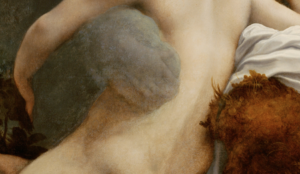 The hand in the haze caressing Io’s left hip emphasises the tactile yet soft and misty presence of the cloud further highlighted by its shadow projected on Io’s left side. Apparently touching her right hip Correggio has placed the jagged branch and bristle leaves of an oak trunk. The tree stands as an attribute of Jupiter, but also as the sharpest element of the painter’s tactile palette composed of rough wood, ticklish leaves, the embrace of a cloud, Io’s exposed flesh as well as the white drapery partly covering her right side.
The hand in the haze caressing Io’s left hip emphasises the tactile yet soft and misty presence of the cloud further highlighted by its shadow projected on Io’s left side. Apparently touching her right hip Correggio has placed the jagged branch and bristle leaves of an oak trunk. The tree stands as an attribute of Jupiter, but also as the sharpest element of the painter’s tactile palette composed of rough wood, ticklish leaves, the embrace of a cloud, Io’s exposed flesh as well as the white drapery partly covering her right side.
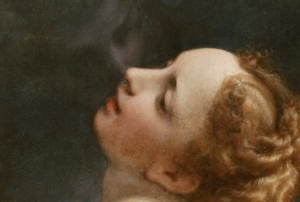 In the picture fumo is also the means by which the mortal Io became the ancestor of many heroes. She literally breathes the embracing cloud which inseminates her. Correggio has emphasised the contact of her nose with the nose of the cloudy figure which is almost melting over her nostril. This detail echoes the belief that the vital spirit can enter or escape through nasal conducts; a common belief enacted in sources as different as Ariosto’s Orlando Furioso, in which the hero recovers his lost wit by these very channels (Canto 34) or as Marteen de Vos’ various versions of the Allegory of smell featuring the Biblical episode of God infusing Adam with spirit.
In the picture fumo is also the means by which the mortal Io became the ancestor of many heroes. She literally breathes the embracing cloud which inseminates her. Correggio has emphasised the contact of her nose with the nose of the cloudy figure which is almost melting over her nostril. This detail echoes the belief that the vital spirit can enter or escape through nasal conducts; a common belief enacted in sources as different as Ariosto’s Orlando Furioso, in which the hero recovers his lost wit by these very channels (Canto 34) or as Marteen de Vos’ various versions of the Allegory of smell featuring the Biblical episode of God infusing Adam with spirit.
Thus hailed by the first art historian, Giorgio Vasari (1511-1574), as the beginning of sixteenth-century modernity, the art of sfumato provides not only a representation of ideas about visual perception, but also enhances the conditions of visibility of the early modern sensory world.
Illustrations:
Marteen de Vos, Allegory of Smell, Antwerp, c. 1560
library.artstor.org/#/asset/24831289;prevRouteTS=1572496740522
Bibliography and main sources in:
Marcin Fabiański, ‘Correggio’s Jupiter and Io: its sources and meaning’, Source: Notes in the History of Art, Vol. 17, No. 1 (Fall 1997), pp. 8-14.
On the porous self:
John Jeffries Martin, Myths of Renaissance Individualism, Basingstoke 2004.
François Quiviger
The Warburg Institute
School of Advanced Study
University of London
francois.quiviger@sas.ac.uk
sas.academia.edu/FrancoisQuiviger
